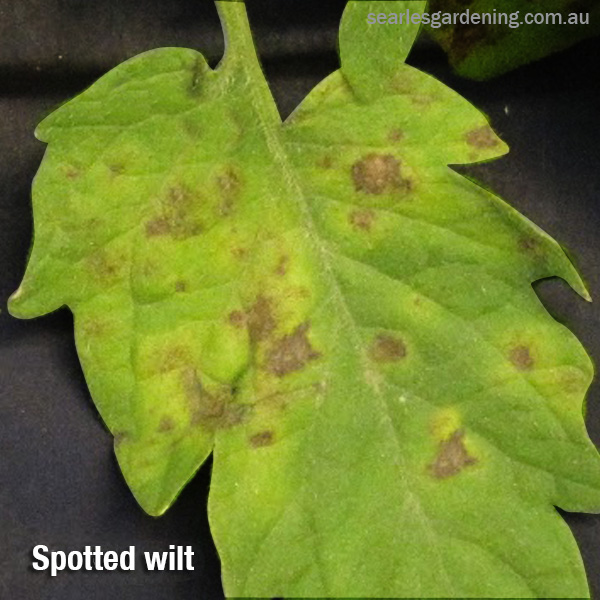Pests & Diseases affecting tomatoes
|
One of the most challenging of home vegetables to grow is arguably the venerable tomato, but when it’s grown well, it is certainly one of the most rewarding and satisfying of garden fruits. The key to great home-grown tomatoes is good soil health, consistent moisture and nutrition, which ensures healthy plants that are able to better withstand pest and disease pressures as they occur.
Good soil health starts with incorporation of 5IN1 Organic Fertiliser before planting. This will help plants to establish strongly. Once they start to flower, apply fortnightly liquid feeds of Searles Flourish Vegie & Tomato Liquid Fertiliser to encourage more flowers and subsequently more fruit. Ensure adequate moisture for your tomatoes at all stages of growth by consistently irrigating and reducing evaporation with a quality organic mulch.
It’s a known fact that tomatoes are one of the most difficult plants on which to diagnose diseases, so the following is purely a guide for home gardeners to help recognise when diseases occur.
Tomato Wilts | Bacterial, Verticillium, Fusarium Characterised by wilting, yellowing (not for bacterial) and death of lower leaves, especially during hot weather. Watering doesn’t relieve the symptoms. Whole plants can die very quickly. Best to remove and destroy infected plants.
Tomato Viruses | Mosaic, Leaf curl Symptoms include stunting and distortion of foliage, mottling and streaking of stems and leaves. Spread in many ways, including sap-sucking insects, garden tools, hands, implements, even old trellises. At the first signs of symptoms, remove and destroy plants.
Moulds, mildews on tomatoes Signs may be white or greyish furry growths on leaves and fruit. Remove infected parts, treat with Searles Lime Sulphur.
Tomato Blights, Leaf Spots & Specks Leaves may develop irregular or circular spots with features and colours ranging from greyish-brown, brown with a yellow halo, concentric rings, and brown with light grey centres. Stems may develop darkish lesions and patches. Treatment should include removal of as much infected material as possible, then spray with Searles Copper Oxychloride for control.
Blossom-end Rot A common tomato problem is blossom-end rot. This appears at the ‘blossom end’ of the fruit - the opposite end to the stem. Initially, this part of the fruit becomes off-white to brown in colour and takes on a ‘sunken in’ appearance. As the fruit matures, these symptoms become more pronounced and the rot darkens in colour.
Blossom end rot is caused by insufficient calcium and the most common cause is irregular or insufficient water during the critical growing period of the young fruit. Even when sufficient calcium is present in the soil, water shortages can create difficulty absorbing and delivering calcium to the fruit.
Fruit Fly (Garden Enemy No. 1) Signs of this pest are discoloured spots and rots developing around the skin area. Eggs hatch into maggots that destroy the soft interior of the fruit.
There are no preventative or systemic sprays for tomatoes, so careful monitoring is required (Searles Fruit Fly wick) from around spring (when the weather warms) to autumn and even winter if temperatures stay high. Searles Fruit Fly Trap will attract, trap and kill male fruit flies only, so use these together with fruit fly exclusion bags/netting for best results.
Budworm The larvae of the potato moth and two budworm species can cause serious damage to tomatoes, by tunnelling into leaves and stems, reducing growth and subsequent flowering and fruiting. Usually by the time damage is seen, the larvae have entered the plants and there are no systemic insecticides that can help. If you see the larvae on the outside of the plant, then Searles Bug Beater Natural Pyrethrum spray is a great low toxicity control.
Whitefly and aphids on tomatoes Whitefly congregate on the underside of tomato leaves, fly away when disturbed, and return quickly to continue feeding. Aphids generally gather at the soft growing tips of tomato plants and can explode in numbers if not controlled. For large infestations of both, Searles Bug Beater Natural Pyrethrum spray is effective when sprayed on the upper and lower surfaces of leaves. Most vegie garden soils will have adequate available calcium, however the problem usually occurs due to inconsistent irrigation practices. Mulch, use organic fertilisers and Searles Penetraide in sandy or loamy soils, and increase irrigation during fruiting and warm periods. Ensure your soil’s pH is around 6.5 to 7.
Tomato Mites Tomato russet mites are tiny sap-suckers that can become a problem in warm, dry weather. They can’t be seen with the naked eye, but symptoms include withering of lower foliage, stems displaying a bronze colour, and leathery skins on fruit. Spray Searles Wettable Sulphur on all leaf surfaces for control.
Article author: Born and bred in Toowoomba, Mike Wells has turned a lifelong passion for plants and gardening into a career as a TAFE horticultural educator for the last 18 years. This passion for all things horticulture has also seen him contribute a widely-read weekly gardening article in the Toowoomba Chronicle since 2013.
|















